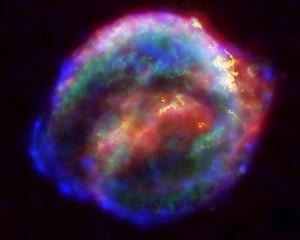Posts Tagged ‘supernova’
Two Type Ia Supernovae?
Type Ia supernovae are “standard candles” with which we measure the universe. We can use them for this purpose because they appear to have definite light curves – that is, their luminosity decreases with time at a predictable rate. Since time and distance are generally interchangeable when dealing with stellar phenomena (both are governed by the speed of light – if we see something happening one light year away, it’s happening one year in the past), we know that the dimmer a Type Ia supernova is, the further away it is, and we can get the particular distance.
Why do Type Ia supernovae have this quality when other supernovae don’t? It’s because of the way they’re formed. They start off as a binary star system with a stable white dwarf star at the center. Over time, the central star accumulates material from its companion star through gravity, and approaches the Chandrasekhar limit – the maximum size a white dwarf can reach without collapsing – which is around 1.4 times the mass of our Sun. Since the supernova occurs right when the white dwarf reaches this limit, the nature of the collapse is pretty close to exact. Here’s a diagram from NASA to illustrate some of the particulars:
